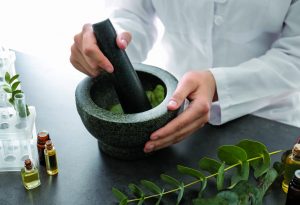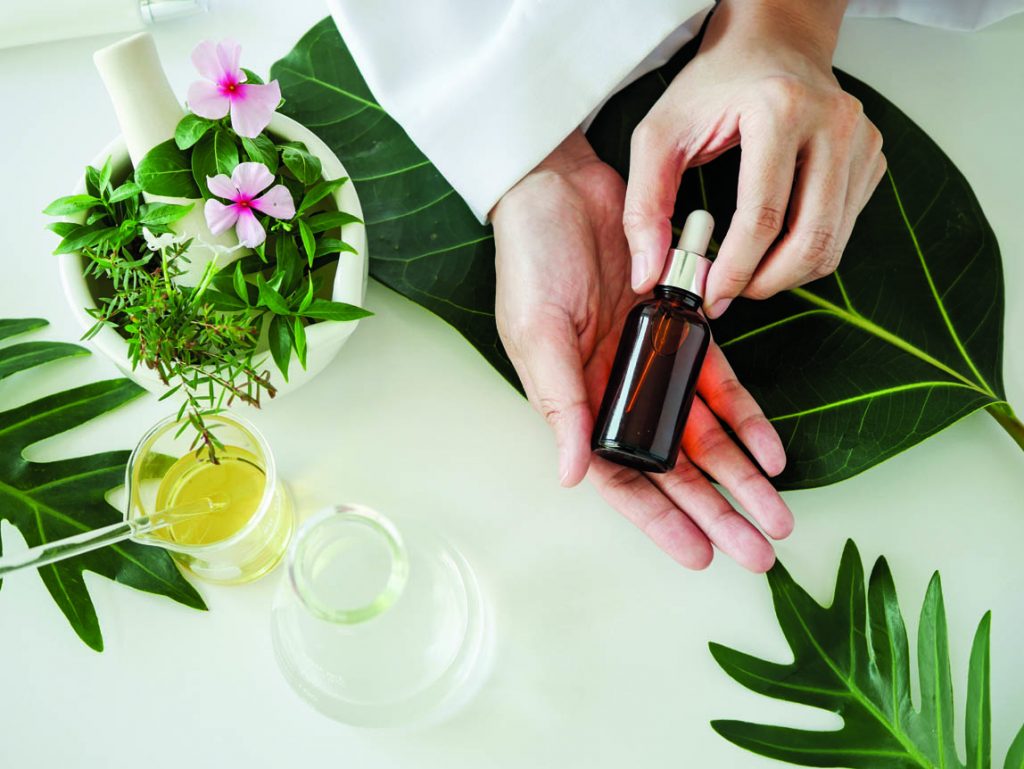The Perception of Natural: Lessons and Predictions October 23, 2019
Summary: This article considers the roles emotion and association play in the perceived value of ‘natural’ within the health and beauty sectors, how changing public opinion from the 1970s to today has changed supplier practices, and what the natural essential oils industry can learn from the historical mistakes made by their chemical-producing competitors in big pharma and lab synthesis.
 A lot has changed in the naturals industry since the Ultra International Group’s story began in 1929 when Mr. Prahalad Roy Sanganeria and Mrs. Radha Devi Sanganeria started selling essential oils under the brand name ‘Lakshmi Bottle Stores’. In analysis conducted this April, Allied Market Research predicted that the global essential oil market will reach $11.19 billion by 2022, almost doubling from 2016 figures, and riding a CAGR of 8.7% in that six-year period. Transcending an illustrious family lineage of essential oil experts, Ultra’s Executive Director Priyamvada Sanganeria thinks that “with more end customers seeking pure, sustainable products, the naturals industry is in a good place”, echoed by her colleague Prasenjit Mazumdar in his statement that “to me, the future is very bright and encouraging as the world is moving more towards naturals”. Integrated within the exploding realm of mindfulness that is sweeping anxiety-ridden millennials globally, as well as the growing trend for functional wellness that attempts to achieve specific performance goals from wellness products, the spotlight on natural essential oils indicates that the industry has nothing to worry about in the coming decade.
A lot has changed in the naturals industry since the Ultra International Group’s story began in 1929 when Mr. Prahalad Roy Sanganeria and Mrs. Radha Devi Sanganeria started selling essential oils under the brand name ‘Lakshmi Bottle Stores’. In analysis conducted this April, Allied Market Research predicted that the global essential oil market will reach $11.19 billion by 2022, almost doubling from 2016 figures, and riding a CAGR of 8.7% in that six-year period. Transcending an illustrious family lineage of essential oil experts, Ultra’s Executive Director Priyamvada Sanganeria thinks that “with more end customers seeking pure, sustainable products, the naturals industry is in a good place”, echoed by her colleague Prasenjit Mazumdar in his statement that “to me, the future is very bright and encouraging as the world is moving more towards naturals”. Integrated within the exploding realm of mindfulness that is sweeping anxiety-ridden millennials globally, as well as the growing trend for functional wellness that attempts to achieve specific performance goals from wellness products, the spotlight on natural essential oils indicates that the industry has nothing to worry about in the coming decade.
What people want now
For Sandeep Tekriwal, CEO of Van Aroma, one of the biggest changes to take place in the last 20 years has been “the huge increase in the demand for naturals from the aromatherapy industry”, disturbing the traditional stranglehold from flavour and fragrance clients on farmer output, also noted by Ultra Director Bhuvana Nageshwaran in her statement that “three decades back, due to growing demand for synthetic aroma chemicals, there was a slump in the consumption of essential oils leading to decrease in growth of this sector”. In a corroborating Telegraph article, aromatherapy expert Gemma Clare revealed that “when I started out as an aromatherapist over 15 years ago, the scientific community could be quite dismissive but thankfully this perspective has changed due to the increased evidence that aromatherapy can benefit us on several levels”, continuing that “aromachology (the relationship between scent and behaviour) is definitely starting to reach consumers who are wanting to feel more vibrant or calm, for example”. Elucidating this strand of thought, Director at NPD UK June Jensen comments that “2019 has been a challenging year and, in uncertain times, customers return to natural, heritage ingredients that offer a comforting, nurturing effect on skin, body and soul”. Recent studies underscore the ripening public appetite for naturals: research analysts Beneo Inc. found that 65% of consumers in the Americas consider natural products as better and 47% actively look for natural products when making food purchase decisions; Racked document a December 2017 study that found 56% of adults surveyed think that it’s important for their personal-care products to be “natural or organic”; whilst Psych Central reports how the majority of US consumers prefer natural products over ‘artificial’ counterparts even when the two are chemically identical and show no difference in their effectiveness or safety rating.
Why they want it
The belief that nature and natural processes are positive and righteous has a history that dates back to the very start of civilisation; the cultural weight nature carries is rooted in deeply held value systems and emotional associations that tie the natural world to healthiness, balance, quality, freshness, nourishment, morality, spirituality, purpose and fulfilment. It is no exaggeration to assume that subconscious links are made between the use of natural essential oils and a sense of sublime soul-enriching enlightenment that has classically been celebrated through natural landscapes and the fruits that they bear. In today’s social landscape, the appeal of natural products extends even further into artistic qualifications: the proposition that naturals oils are more interesting than their synthetic parallels, possessing endless levels of personality and character, whether it be concerning intensity (such as the uplifting sharpness of citrus) or complexity (such as all of the nuanced oddities and facets of patchouli). The scientific community sometimes criticises that the ‘natural is better’ view is based on misinformation; sometimes that view is correct. Take the trend for ‘raw water’ (drinking unprocessed, unfiltered, untreated water direct from rivers and lakes that are often contaminated with dangerous bacteria), or reports that many women in the UK were forced into ‘natural’ childbirth by midwives, intimidated into avoiding anaesthesia or caesarean section.
 A 2015 paper from the Nuffield Council on Bioethics found that “participants often equated naturalness with rightness, and unnatural with wrongness. Describing a technology or product as natural was commonly employed to express ideas about acceptability, safety, and healthiness. In contrast, the use of unnatural often conveyed ideas of unacceptability, dangerousness, and unease”. For the health and beauty sectors, this is powerful information. Givaudan’s Sophie Davodeau, Consumer Sensory Insights Head for the EMEA region, offers that in general, to consumers, natural means ‘as intended by nature’, and is pure and unprocessed in some way – it retains its natural integrity. In France, for example, we found that what is most important is the ecological aspect of natural. In the UK, it’s about going back in time to a more natural era, when food was simpler and less processed. Germany puts more emphasis on organic, and for Russians it’s about resistance to chemicals in their food…very different nuances.
A 2015 paper from the Nuffield Council on Bioethics found that “participants often equated naturalness with rightness, and unnatural with wrongness. Describing a technology or product as natural was commonly employed to express ideas about acceptability, safety, and healthiness. In contrast, the use of unnatural often conveyed ideas of unacceptability, dangerousness, and unease”. For the health and beauty sectors, this is powerful information. Givaudan’s Sophie Davodeau, Consumer Sensory Insights Head for the EMEA region, offers that in general, to consumers, natural means ‘as intended by nature’, and is pure and unprocessed in some way – it retains its natural integrity. In France, for example, we found that what is most important is the ecological aspect of natural. In the UK, it’s about going back in time to a more natural era, when food was simpler and less processed. Germany puts more emphasis on organic, and for Russians it’s about resistance to chemicals in their food…very different nuances.
A 2015 paper from the Nuffield Council on Bioethics found that “participants often equated naturalness with rightness, and unnatural with wrongness.

How to win
Whilst it may seem that naturals are untouchable today, the case was very different 50 years ago. The efficiency of mass-production that followed the Second World War saw mechanical innovation capture the hearts and minds of many that previously relied on simple natural sources for food and everyday products; whilst the appreciation for nature never left them, the idea of preservation or sustainability of natural habitats was not equivalent to the potential to be gained from human progress. Consumer trust shifted from local business to global corporations that offered factory-driven precision, remarkable consistency, and lightning-fast turnarounds. Exclusivity resided in being able to get the same result time and time again and getting it whenever you want, rather than in the unique, sometimes inconsistent results of nature.
But then the image of large chemical and medicine companies changed – promises not kept, public health concerns and malpractice from capital greed contributed to a deep suspicion (such as cigarettes, asbestos, nitro musks, even the Chernobyl disaster falls into this category). One too many bad incidents created irreparable scepticism about the true intention of closed-door labs in medicine and consumer products. Vox journalist Jen Kirby believes the strong swing towards all-natural philosophies find their footing because “traditional medicine has failed people in many cases, and often lacks solutions for the most common health woes — chronic pain, obesity, Alzheimer’s. You need not look any further than the raging opioid epidemic to find cases where medicine has also done more harm than good”.
Instead of focusing on end-consumer needs and emotions, synthetic chemical manufacturing giants placed their efforts entirely on satisfying client goals, not fully informing the public about quality assurance and not even fully understanding the effects of their products themselves. This is something the naturals community is not immune to: Tekriwal suggests that “with severe competition and easy knowledge access, every player wishes to source naturals from the cheapest available source thereby compromising on the quality and sourcing naturals responsibly”. It is not entirely impossible to imagine a future in which the largest natural players have avoided best-practice QC procedures and demands for sustainability and are then seen to be blamed for dwindling crops and their poor quality profiles, with general opinion and trust swinging back to chemicals and what they are able to achieve.
It is important that naturals focus on the consumer demands that are driving the big ideas of this century and don’t get distracted by short-term gain, pinpointing areas for innovation such as “[the] scarcity of water due to depletion of sources … decreased farming landscape due to the massive extension of urbanisation … adulteration … and camouflaging synthetic essential oils as natural essential oils”, as suggested by Nageshwaran, to ensure the reputation of naturals remains high. In Tekriwal’s view, “as markets mature and demand for naturals increase, smaller and marginal players will find it difficult to survive by just selling cheap. Suppliers who innovate, are closer to the ground sources for supplies, and commit to sustainable practices will thrive”. Whilst natural products used to be connected exclusively to small business because it was so difficult to manage oil networks globally and atscale, it is now larger groups like Ultra that are poised to make the biggest difference and capitalise on the world’s revived passion for all thing natural via new ways to share expertise and new initiatives concentrated on giving back to the soil and communities alike.
Eddie Bulliqi
 Ultra International B.V.
Ultra International B.V.